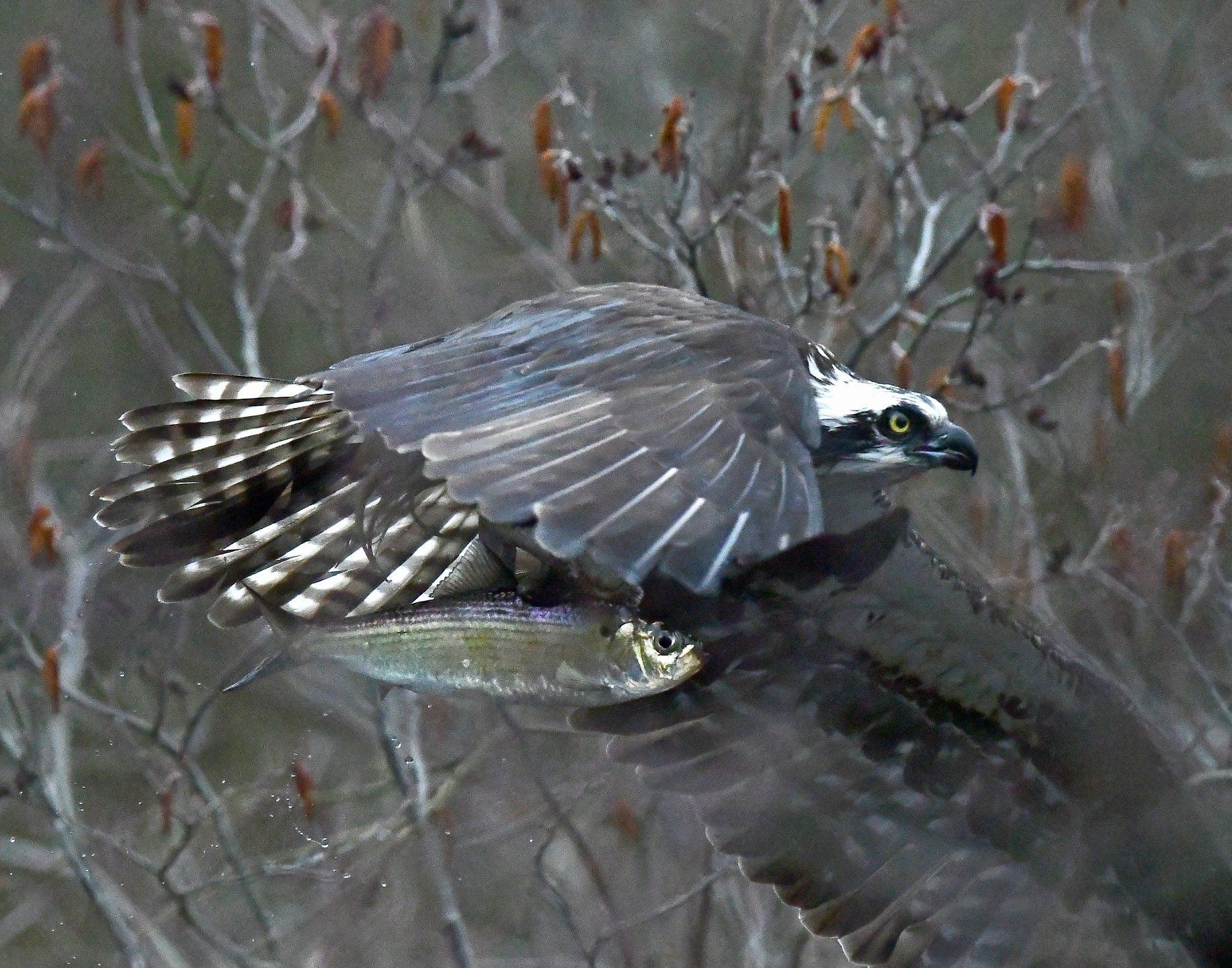

Osprey Frequently Asked Questions (FAQ)
- I lost my personalized link for Osprey data submission. Where do I go now?
- I have found a nest that is not on the Audubon Osprey nest map, what do I do?
- Why are there traffic cones and / or bird spikes on an area where there was previously an Osprey nest?
- How do I become a monitor?
- Does Audubon erect and maintain nest poles?
- How long is the Osprey monitoring season?
- How many eggs does an Osprey lay?
- How long does it take from an Osprey egg being laid to becoming a fledgling?
- What is the difference between a nestling and a fledgling?
- Why are male Ospreys harassing other Ospreys in nearby nests?
- How far do Ospreys migrate?
- How long do Ospreys live?
- Where do Ospreys like to nest?
-
I lost my personalized link for Osprey data submission. Where do I go now?
Northern RI Region Observation Data Submission Form link: https://forms.gle/9aUwBx8wJqBdHt9i8
East Bay RI Region Observation Data Submission Form link: https://forms.gle/xKBSJWoH6Z7paHHL7
Southern RI Region Observation Data Submission Form link: https://forms.gle/UVifvRJ8hpAV38BF6
Multiple Regions in RI Observation Data Submission Form link: https://forms.gle/EwDsxdhzAtGCtnKr9Your "password" for Login is simply the email address that you use for communication with Lincoln, with no capital letters.
-
I have found a nest that is not on the Audubon Osprey nest map, what do I do?
Email the program coordinator Lincoln Dark at LDark@asri.org.
-
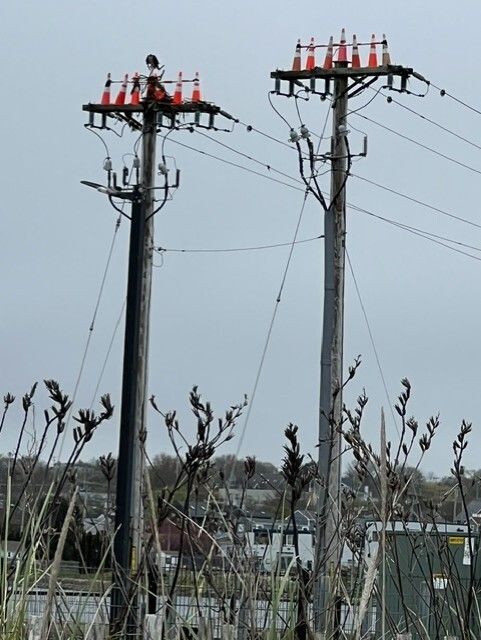 Why are there traffic cones and / or bird spikes on an area where there was previously an Osprey nest?
Why are there traffic cones and / or bird spikes on an area where there was previously an Osprey nest?Deterring Osprey nests is a common practice by private landowners and energy companies to prevent damage to infrastructure. However, a permit must be acquired from the U.S Fish & Wildlife Service to do so. Furthermore, even with a permit, if the nest is found to have eggs, nestlings, or fledglings, then the permit is nullified. Power companies will reach out to Audubon as part of the permit application process to learn more about nest activity.
Still, Osprey nests on utility poles can cause power outages due to interfering with wires and components (https://tinyurl.com/4u524p78). Nesting deterrents on utility poles do serve some benefit to the Ospreys as well. Nests on utility poles can catch fire due to flammable nest materials being so close to high-voltage wires.
-
How do I become a monitor?
Email the program coordinator Lincoln Dark at LDark@asri.org.
-
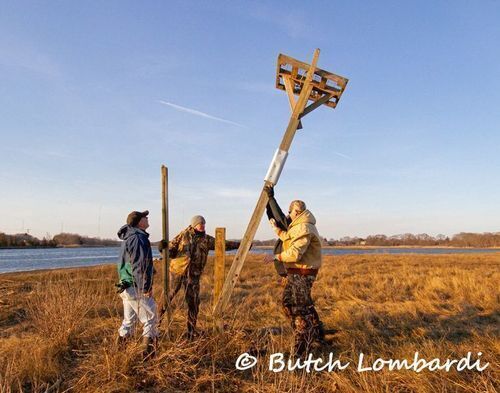 Does Audubon erect and maintain nest poles?
Does Audubon erect and maintain nest poles?While the Audubon Society of Rhode Island does maintain a handful of Osprey nesting poles and platforms on our Wildlife Refuges, we do not actively erect and maintain poles in the community. If you are interested in installing a pole and platform on your property or in your neighborhood, please click here for a guide, or contact Dr. Charles Clarkson, Audubon’s Director of Avian Research, at cclarkson@asri.org for more information.
-
How long is the Osprey monitoring season?
Audubon begins collecting data on Osprey nests in mid-April. Even though you may see Osprey nests in March, they may be scouting out nests and not actively breeding. The season ends in mid-August; however, we may continue to collect data on some “late bloomers” that will stay through the early days of September.
-
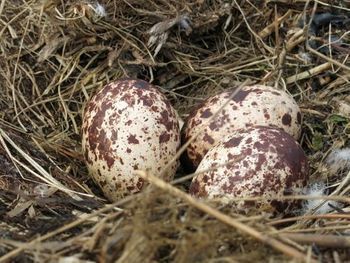 How many eggs does an Osprey lay?
How many eggs does an Osprey lay?Typically 3, but sometimes 2, and rarely 4. In Rhode Island, out of the 370 nests we monitor, only a single nest may end up with 4 eggs in a season. Click here to learn more about the Osprey breeding behaviors.
-
How long does it take from an Osprey egg being laid to becoming a fledgling?
Typically between 82 and 102 days. Eggs are laid in May through early June, then the young are able to fly by August through early September.
-
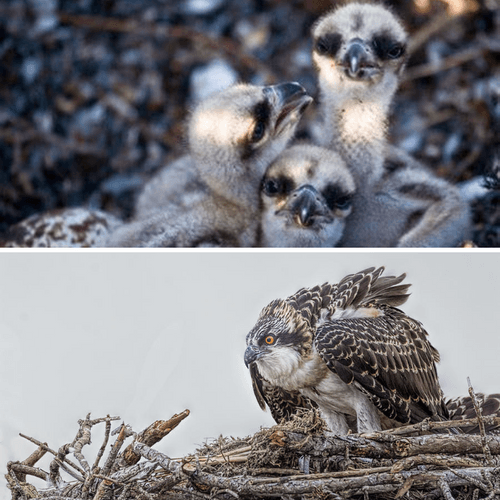 What is the difference between a nestling and a fledgling?
What is the difference between a nestling and a fledgling?An Osprey is considered a “nestling” when it has first hatched, it cannot fly, and is covered with downy feathers that are tan or brown in coloration (top image). An Osprey is considered a “fledgling” when it has grown its flight feathers (bottom image). The fledglings are only slightly smaller than adult Ospreys, have a dark orange eye (compared to the light yellow eye of the adults), and have a “salt and pepper” pattern on their wings (compared to the solid black color of the adult wings).
-
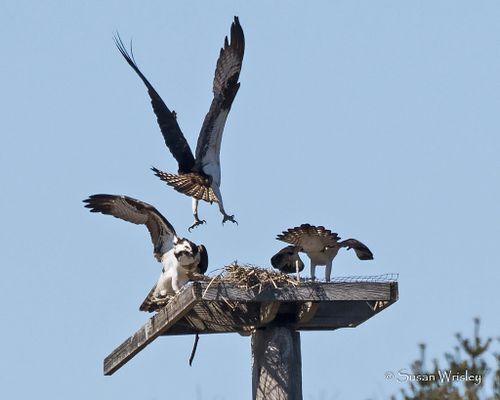 Why are male Ospreys harassing other Ospreys in nearby nests?
Why are male Ospreys harassing other Ospreys in nearby nests?This is a common occurrence in areas where there is a high density of Osprey nests. It is a symptom of a growing population. Unfortunately, this territorial behavior can lead to a decline in the number of young Osprey that survive the season, as parents spend more time defending their nest than foraging for food.
-
How far do Ospreys migrate?
Ospreys that spend the breeding season (summertime) in the US will spend their non-breeding season (wintertime) in Central and South America. In an Osprey’s life, it may fly as much as 125,000 miles!
-
How long do Ospreys live?
Ospreys typically live 8-10 years. The most long-lived Osprey lived to be 32 years old!
-
Where do Ospreys like to nest?
Ospreys will nest in a variety of habitats, including coastal areas, inland areas, forests, and urban areas. They prefer to nest on the tallest structure in an area, whether it be a tree, cliffside, utility pole, cell phone tower, or Osprey nest platform. They prefer these high-up areas to have a vantage point to be aware of any nearby predators.
Support Our Work
Your generosity will help sustain and grow our conservation, education, and advocacy efforts right here in Rhode Island!
Visit Us
Start exploring nearly 10,000 acres of natural habitat across Rhode Island and nearby Massachusetts.
Programs and Events
Get outside and learn about the natural world!

















